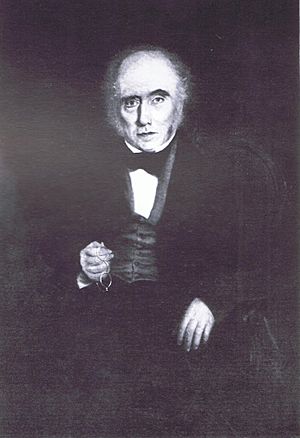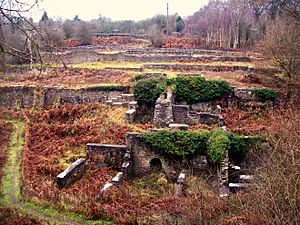David Mushet facts for kids
Quick facts for kids
David Mushet
|
|
|---|---|
 |
|
| Born | 2 October 1772 |
| Died | 7 June 1847 (aged 74) |
| Resting place | All Saints churchyard, Staunton |
| Occupation | Metallurgist |
| Known for | Inventing a method to produce refined iron direct from the blast furnace, without the need for a separate refinery. |
| Parent(s) | William Mushet, Margaret Cochran |
David Mushet (born October 2, 1772 – died June 7, 1847) was a clever Scottish engineer. He made many important discoveries in how to make and work with metals, especially iron. This field is called metallurgy. David Mushet also cared a lot about animal rights and spoke up for animals.
Contents
Early Life and Learning
David Mushet was born on October 2, 1772. He was the youngest son of William and Margaret Mushet. His hometown was Dalkeith, near Edinburgh. He went to Dalkeith Grammar School.
When David was a boy, his father, who was a weaver, started an iron foundry. David sometimes went with his father to this ironworks. These visits sparked his lifelong interest in making iron.
Working in Scotland
David left school at age 19. He did not join his father's foundry right away. Instead, because he was good at math, he became an accountant. He worked at the Clyde Iron Works near Glasgow.
While working there, he read many books about making iron. In 1793, after some staff cuts, he began doing his own experiments. At first, his bosses liked his experiments. He even taught the manager's son about testing metals.
But later, they told him he could not experiment during work hours. So, he worked on his experiments at night. He often stayed up very late. In just a few years, he became an expert in making iron.
In 1800, he got a patent for a new way to make steel from iron. He sold this idea to a company for £3,000. His employers at Clyde Iron Works became jealous. They fired him that same year.
The next year, he bought and rebuilt the Calder Iron Works. He continued his experiments there. In 1801, he made another big discovery. He found that "Black-band Ironstone" could be used to make iron cheaply. This stone was often found with a type of coal that people thought was useless.
His discovery helped the Scottish iron industry grow a lot. It made millions of pounds for other business owners. But David Mushet himself did not get much money from it.
By 1805, Mushet had written about 30 articles for a science magazine. People everywhere saw him as an expert. He wanted to do more and decided to move on.
Working in England
In 1805, David Mushet moved to Derbyshire, England. He became the manager of the Alfreton Ironworks. While there, he joined the Geological Society. He also wrote many important articles about iron. These were published in magazines and encyclopedias, like the Encyclopædia Britannica.
In 1808, a rich investor named Thomas Halford asked for Mushet's help. Halford owned two furnaces at Whitecliff in the Forest of Dean. He was having trouble making enough good quality iron. Mushet agreed to help him.
Mushet designed and oversaw a big rebuilding project at the Whitecliff Ironworks. He spent a lot of time in the Forest of Dean. This caused problems with his colleagues back at Alfreton. In 1810, he moved to Coleford to manage the Whitecliff works full-time. He also bought a share of the business. His wife, Agnes, and their six children joined him later.

Mushet managed the Whitecliff furnaces for six months. Then he quickly left the partnership. We don't know exactly why he left. He usually thought things through carefully.
After moving to the Forest of Dean, Mushet wisely invested in local businesses. He mostly invested in coal mines. For several years, he lived off the money from these investments. During this time, he did experiments in a stone barn near his house.
In 1815, he found a way to make refined iron directly from the blast furnace. This meant he didn't need a separate refining step. He got a patent for this new process. Some of the iron he made was actually steel. He even used razors made from this steel for ten years!
Around 1818 or 1819, he built a foundry at Darkhill in the Forest of Dean. He sold a good amount of iron from there. But he mostly used the works for research and experiments. In 1826, he became a director of the British Iron Company.
By the late 1820s, he had built a large business. It included iron mines and coal mines. He also owned shares in the tramroads that connected them. He was on the committee of the Severn and Wye Railway and Canal Company. He used his position to stop steam railways from expanding into the Forest. This helped protect his tramroad business.
In 1845, David retired and moved to Monmouth. He gave Darkhill to his three sons. His youngest son, Robert Mushet, became the manager.
Today, the remains of Darkhill are a preserved historical site. It is open for people to visit.
Family Life
David Mushet married Agnes Wilson in 1798. Their first child, Margaret, was born in 1799. They had eight children in total. Their last child, Robert, was born in 1811. Robert also became a famous metallurgist, learning from his father.
David Mushet died in Monmouth on June 7, 1847. His wife, Agnes, died in 1854. They are buried together in Staunton churchyard.
Caring for Animals
David Mushet was one of the first people to speak up for animal rights. He was against vivisection, which is experimenting on live animals. He was not a vegetarian, though.
He wrote an essay for a competition held by the Society for the Prevention of Cruelty to Animals. In his essay, he wrote about how cruel it was to animals to hunt them. He also wrote about overworking horses and using dogs to pull carts. His essay was published in 1839 as The Wrongs of the Animal World.
Selected Publications
- The Wrongs of the Animal World (1839)
- Papers on Iron and Steel, Practical and Experimental (1840)
See Also


